Post-THR Recovery: Comprehensive Evidence Search on Physical Therapy
VerifiedAdded on 2023/06/10
|8
|1485
|93
Report
AI Summary
This report outlines the process of conducting an evidence-based search related to the impact of physical therapy and comprehensive self-management education on chronic pain and physical functioning in postoperative total hip replacement (THR) patients. The search strategy involved identifying relevant keywords from the PICO framework (physical therapy, education, discharge education, post-operative total hip replacement, and the synonym hip arthroplasty), selecting appropriate databases such as The Cochrane Library, PubMed, and Google Scholar, and employing effective search strategies using Boolean operators and delimiters to refine the results. The evaluation of evidence focused on level I evidence (randomized controlled trials and systematic reviews), assessing internal and external validity, and examining factors affecting the quality of evidence. The report includes a record of the best search conducted on PubMed and concludes with a summary of the key steps in the evidence search process.
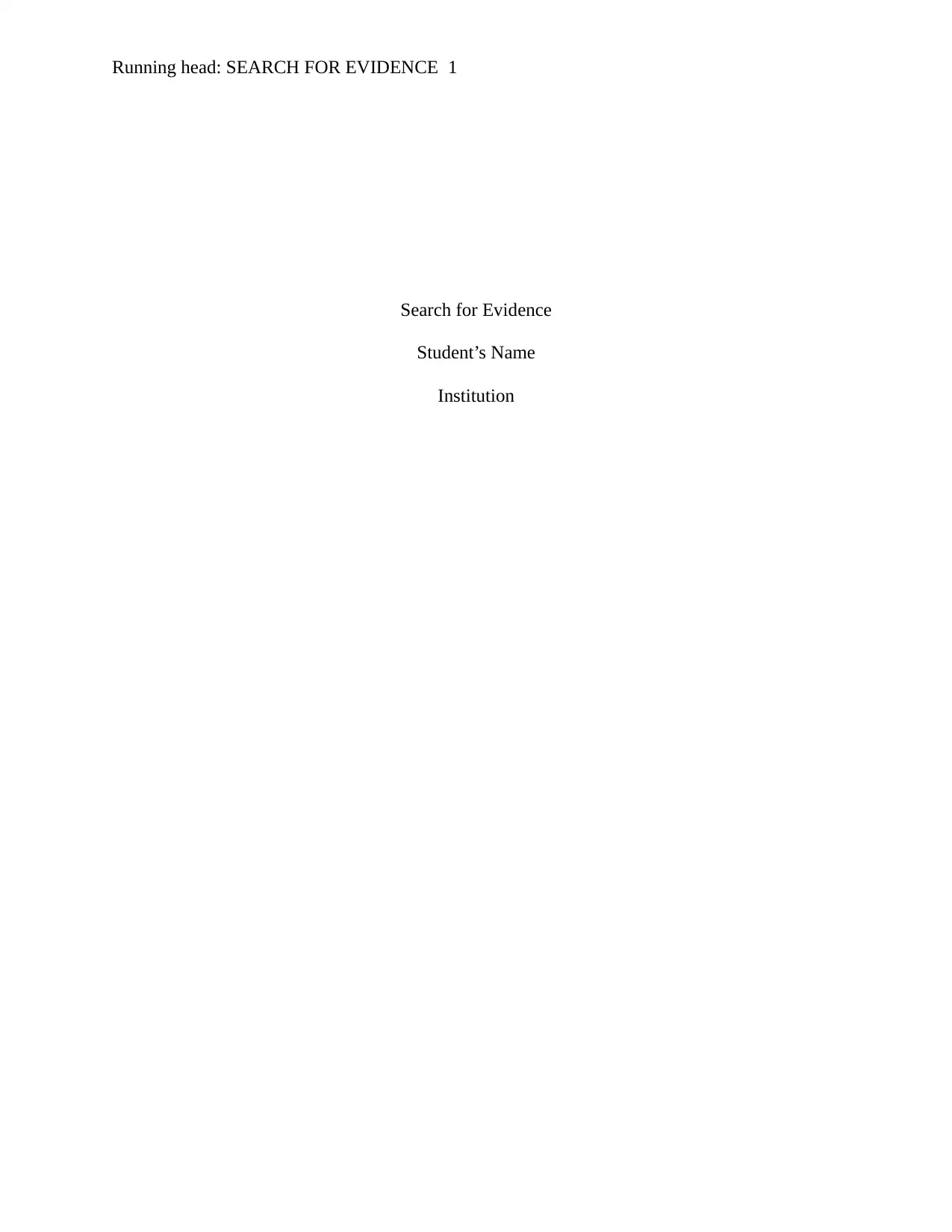
Running head: SEARCH FOR EVIDENCE 1
Search for Evidence
Student’s Name
Institution
Search for Evidence
Student’s Name
Institution
Paraphrase This Document
Need a fresh take? Get an instant paraphrase of this document with our AI Paraphraser
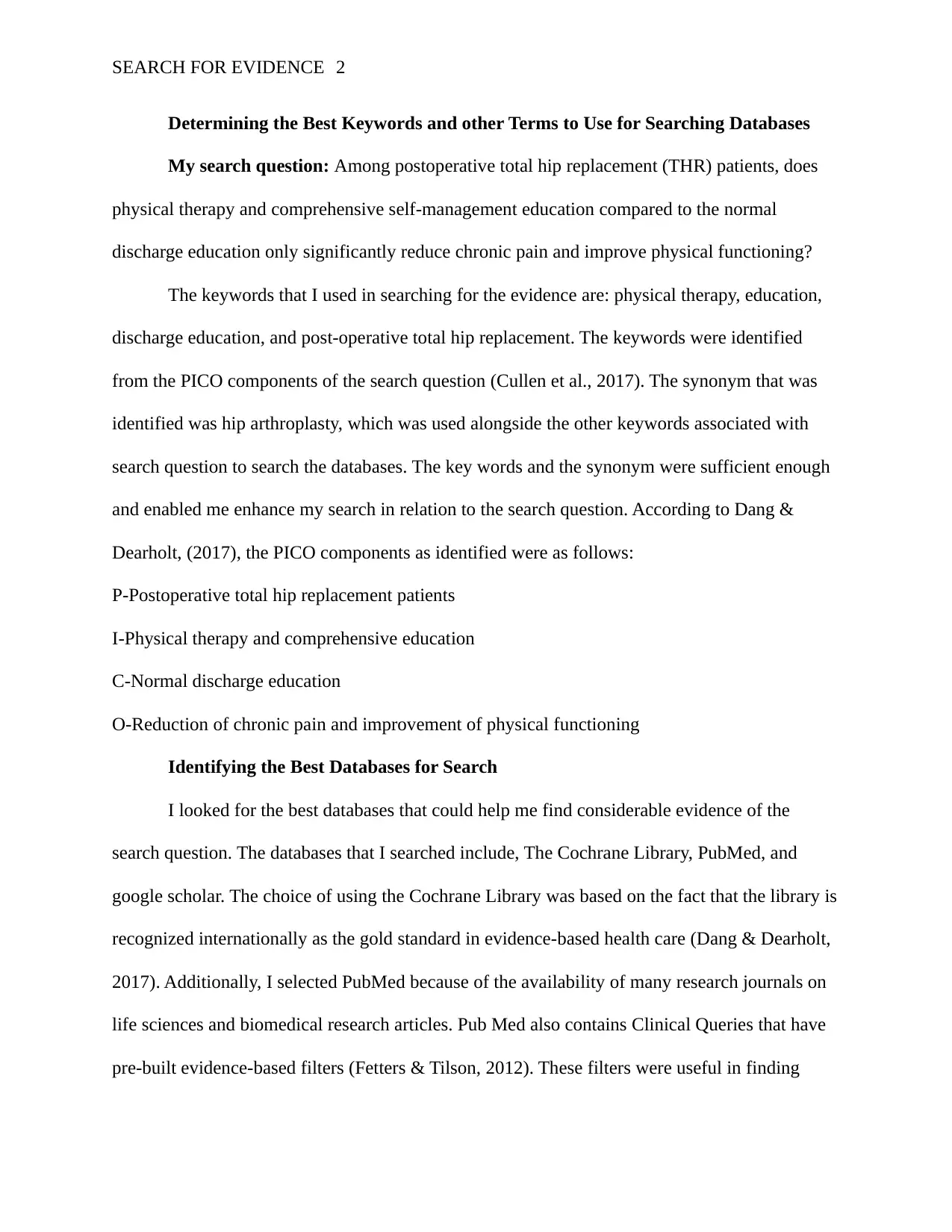
SEARCH FOR EVIDENCE 2
Determining the Best Keywords and other Terms to Use for Searching Databases
My search question: Among postoperative total hip replacement (THR) patients, does
physical therapy and comprehensive self-management education compared to the normal
discharge education only significantly reduce chronic pain and improve physical functioning?
The keywords that I used in searching for the evidence are: physical therapy, education,
discharge education, and post-operative total hip replacement. The keywords were identified
from the PICO components of the search question (Cullen et al., 2017). The synonym that was
identified was hip arthroplasty, which was used alongside the other keywords associated with
search question to search the databases. The key words and the synonym were sufficient enough
and enabled me enhance my search in relation to the search question. According to Dang &
Dearholt, (2017), the PICO components as identified were as follows:
P-Postoperative total hip replacement patients
I-Physical therapy and comprehensive education
C-Normal discharge education
O-Reduction of chronic pain and improvement of physical functioning
Identifying the Best Databases for Search
I looked for the best databases that could help me find considerable evidence of the
search question. The databases that I searched include, The Cochrane Library, PubMed, and
google scholar. The choice of using the Cochrane Library was based on the fact that the library is
recognized internationally as the gold standard in evidence-based health care (Dang & Dearholt,
2017). Additionally, I selected PubMed because of the availability of many research journals on
life sciences and biomedical research articles. Pub Med also contains Clinical Queries that have
pre-built evidence-based filters (Fetters & Tilson, 2012). These filters were useful in finding
Determining the Best Keywords and other Terms to Use for Searching Databases
My search question: Among postoperative total hip replacement (THR) patients, does
physical therapy and comprehensive self-management education compared to the normal
discharge education only significantly reduce chronic pain and improve physical functioning?
The keywords that I used in searching for the evidence are: physical therapy, education,
discharge education, and post-operative total hip replacement. The keywords were identified
from the PICO components of the search question (Cullen et al., 2017). The synonym that was
identified was hip arthroplasty, which was used alongside the other keywords associated with
search question to search the databases. The key words and the synonym were sufficient enough
and enabled me enhance my search in relation to the search question. According to Dang &
Dearholt, (2017), the PICO components as identified were as follows:
P-Postoperative total hip replacement patients
I-Physical therapy and comprehensive education
C-Normal discharge education
O-Reduction of chronic pain and improvement of physical functioning
Identifying the Best Databases for Search
I looked for the best databases that could help me find considerable evidence of the
search question. The databases that I searched include, The Cochrane Library, PubMed, and
google scholar. The choice of using the Cochrane Library was based on the fact that the library is
recognized internationally as the gold standard in evidence-based health care (Dang & Dearholt,
2017). Additionally, I selected PubMed because of the availability of many research journals on
life sciences and biomedical research articles. Pub Med also contains Clinical Queries that have
pre-built evidence-based filters (Fetters & Tilson, 2012). These filters were useful in finding
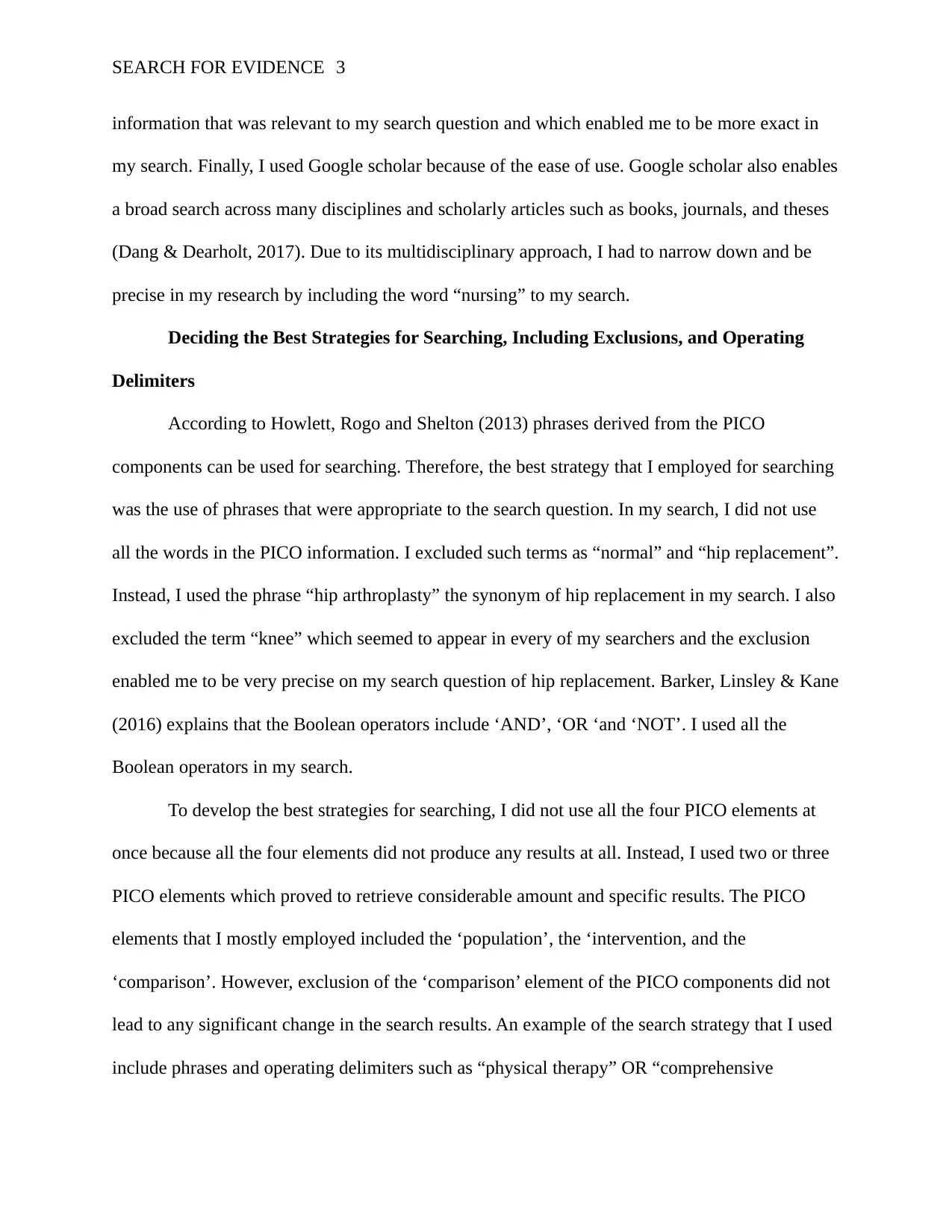
SEARCH FOR EVIDENCE 3
information that was relevant to my search question and which enabled me to be more exact in
my search. Finally, I used Google scholar because of the ease of use. Google scholar also enables
a broad search across many disciplines and scholarly articles such as books, journals, and theses
(Dang & Dearholt, 2017). Due to its multidisciplinary approach, I had to narrow down and be
precise in my research by including the word “nursing” to my search.
Deciding the Best Strategies for Searching, Including Exclusions, and Operating
Delimiters
According to Howlett, Rogo and Shelton (2013) phrases derived from the PICO
components can be used for searching. Therefore, the best strategy that I employed for searching
was the use of phrases that were appropriate to the search question. In my search, I did not use
all the words in the PICO information. I excluded such terms as “normal” and “hip replacement”.
Instead, I used the phrase “hip arthroplasty” the synonym of hip replacement in my search. I also
excluded the term “knee” which seemed to appear in every of my searchers and the exclusion
enabled me to be very precise on my search question of hip replacement. Barker, Linsley & Kane
(2016) explains that the Boolean operators include ‘AND’, ‘OR ‘and ‘NOT’. I used all the
Boolean operators in my search.
To develop the best strategies for searching, I did not use all the four PICO elements at
once because all the four elements did not produce any results at all. Instead, I used two or three
PICO elements which proved to retrieve considerable amount and specific results. The PICO
elements that I mostly employed included the ‘population’, the ‘intervention, and the
‘comparison’. However, exclusion of the ‘comparison’ element of the PICO components did not
lead to any significant change in the search results. An example of the search strategy that I used
include phrases and operating delimiters such as “physical therapy” OR “comprehensive
information that was relevant to my search question and which enabled me to be more exact in
my search. Finally, I used Google scholar because of the ease of use. Google scholar also enables
a broad search across many disciplines and scholarly articles such as books, journals, and theses
(Dang & Dearholt, 2017). Due to its multidisciplinary approach, I had to narrow down and be
precise in my research by including the word “nursing” to my search.
Deciding the Best Strategies for Searching, Including Exclusions, and Operating
Delimiters
According to Howlett, Rogo and Shelton (2013) phrases derived from the PICO
components can be used for searching. Therefore, the best strategy that I employed for searching
was the use of phrases that were appropriate to the search question. In my search, I did not use
all the words in the PICO information. I excluded such terms as “normal” and “hip replacement”.
Instead, I used the phrase “hip arthroplasty” the synonym of hip replacement in my search. I also
excluded the term “knee” which seemed to appear in every of my searchers and the exclusion
enabled me to be very precise on my search question of hip replacement. Barker, Linsley & Kane
(2016) explains that the Boolean operators include ‘AND’, ‘OR ‘and ‘NOT’. I used all the
Boolean operators in my search.
To develop the best strategies for searching, I did not use all the four PICO elements at
once because all the four elements did not produce any results at all. Instead, I used two or three
PICO elements which proved to retrieve considerable amount and specific results. The PICO
elements that I mostly employed included the ‘population’, the ‘intervention, and the
‘comparison’. However, exclusion of the ‘comparison’ element of the PICO components did not
lead to any significant change in the search results. An example of the search strategy that I used
include phrases and operating delimiters such as “physical therapy” OR “comprehensive
⊘ This is a preview!⊘
Do you want full access?
Subscribe today to unlock all pages.

Trusted by 1+ million students worldwide
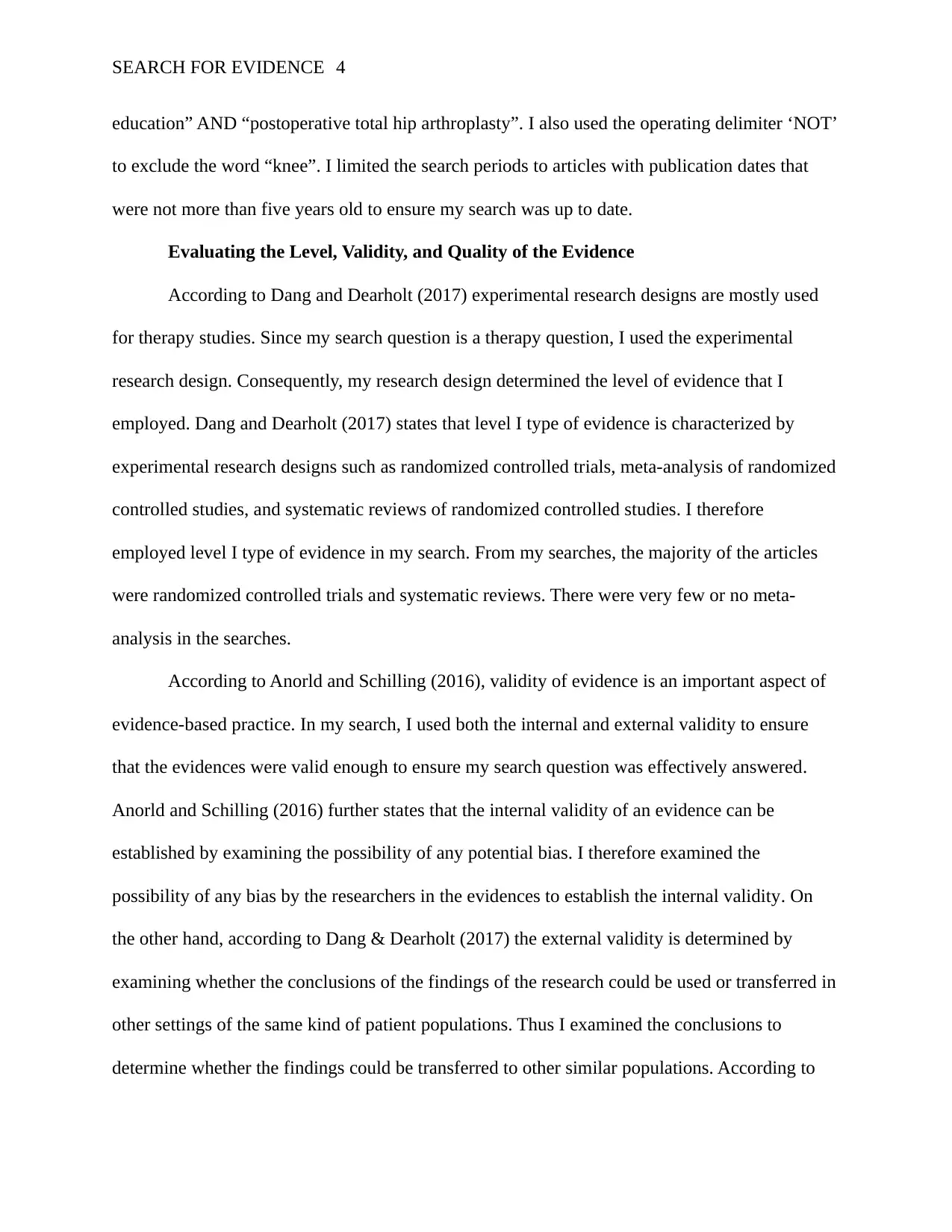
SEARCH FOR EVIDENCE 4
education” AND “postoperative total hip arthroplasty”. I also used the operating delimiter ‘NOT’
to exclude the word “knee”. I limited the search periods to articles with publication dates that
were not more than five years old to ensure my search was up to date.
Evaluating the Level, Validity, and Quality of the Evidence
According to Dang and Dearholt (2017) experimental research designs are mostly used
for therapy studies. Since my search question is a therapy question, I used the experimental
research design. Consequently, my research design determined the level of evidence that I
employed. Dang and Dearholt (2017) states that level I type of evidence is characterized by
experimental research designs such as randomized controlled trials, meta-analysis of randomized
controlled studies, and systematic reviews of randomized controlled studies. I therefore
employed level I type of evidence in my search. From my searches, the majority of the articles
were randomized controlled trials and systematic reviews. There were very few or no meta-
analysis in the searches.
According to Anorld and Schilling (2016), validity of evidence is an important aspect of
evidence-based practice. In my search, I used both the internal and external validity to ensure
that the evidences were valid enough to ensure my search question was effectively answered.
Anorld and Schilling (2016) further states that the internal validity of an evidence can be
established by examining the possibility of any potential bias. I therefore examined the
possibility of any bias by the researchers in the evidences to establish the internal validity. On
the other hand, according to Dang & Dearholt (2017) the external validity is determined by
examining whether the conclusions of the findings of the research could be used or transferred in
other settings of the same kind of patient populations. Thus I examined the conclusions to
determine whether the findings could be transferred to other similar populations. According to
education” AND “postoperative total hip arthroplasty”. I also used the operating delimiter ‘NOT’
to exclude the word “knee”. I limited the search periods to articles with publication dates that
were not more than five years old to ensure my search was up to date.
Evaluating the Level, Validity, and Quality of the Evidence
According to Dang and Dearholt (2017) experimental research designs are mostly used
for therapy studies. Since my search question is a therapy question, I used the experimental
research design. Consequently, my research design determined the level of evidence that I
employed. Dang and Dearholt (2017) states that level I type of evidence is characterized by
experimental research designs such as randomized controlled trials, meta-analysis of randomized
controlled studies, and systematic reviews of randomized controlled studies. I therefore
employed level I type of evidence in my search. From my searches, the majority of the articles
were randomized controlled trials and systematic reviews. There were very few or no meta-
analysis in the searches.
According to Anorld and Schilling (2016), validity of evidence is an important aspect of
evidence-based practice. In my search, I used both the internal and external validity to ensure
that the evidences were valid enough to ensure my search question was effectively answered.
Anorld and Schilling (2016) further states that the internal validity of an evidence can be
established by examining the possibility of any potential bias. I therefore examined the
possibility of any bias by the researchers in the evidences to establish the internal validity. On
the other hand, according to Dang & Dearholt (2017) the external validity is determined by
examining whether the conclusions of the findings of the research could be used or transferred in
other settings of the same kind of patient populations. Thus I examined the conclusions to
determine whether the findings could be transferred to other similar populations. According to
Paraphrase This Document
Need a fresh take? Get an instant paraphrase of this document with our AI Paraphraser
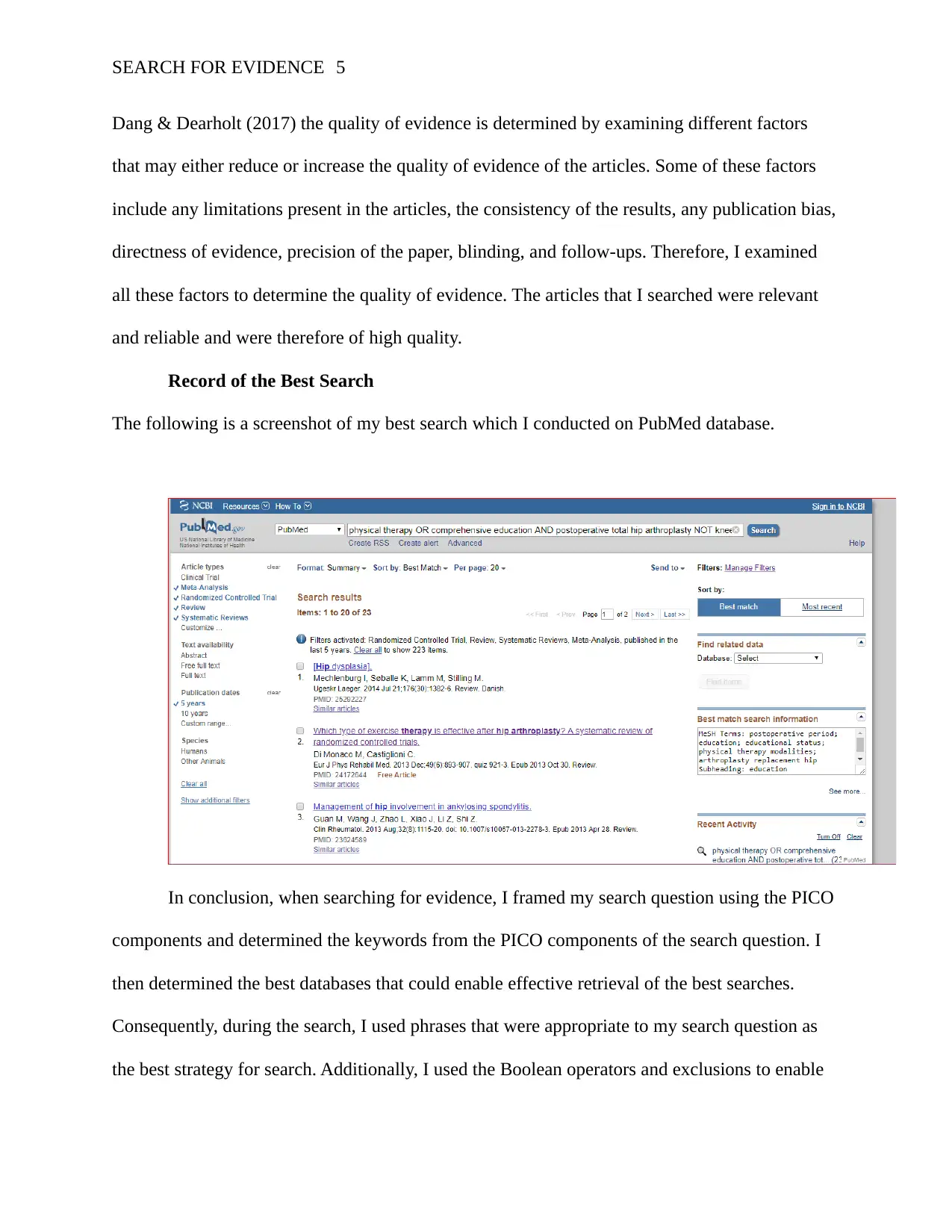
SEARCH FOR EVIDENCE 5
Dang & Dearholt (2017) the quality of evidence is determined by examining different factors
that may either reduce or increase the quality of evidence of the articles. Some of these factors
include any limitations present in the articles, the consistency of the results, any publication bias,
directness of evidence, precision of the paper, blinding, and follow-ups. Therefore, I examined
all these factors to determine the quality of evidence. The articles that I searched were relevant
and reliable and were therefore of high quality.
Record of the Best Search
The following is a screenshot of my best search which I conducted on PubMed database.
In conclusion, when searching for evidence, I framed my search question using the PICO
components and determined the keywords from the PICO components of the search question. I
then determined the best databases that could enable effective retrieval of the best searches.
Consequently, during the search, I used phrases that were appropriate to my search question as
the best strategy for search. Additionally, I used the Boolean operators and exclusions to enable
Dang & Dearholt (2017) the quality of evidence is determined by examining different factors
that may either reduce or increase the quality of evidence of the articles. Some of these factors
include any limitations present in the articles, the consistency of the results, any publication bias,
directness of evidence, precision of the paper, blinding, and follow-ups. Therefore, I examined
all these factors to determine the quality of evidence. The articles that I searched were relevant
and reliable and were therefore of high quality.
Record of the Best Search
The following is a screenshot of my best search which I conducted on PubMed database.
In conclusion, when searching for evidence, I framed my search question using the PICO
components and determined the keywords from the PICO components of the search question. I
then determined the best databases that could enable effective retrieval of the best searches.
Consequently, during the search, I used phrases that were appropriate to my search question as
the best strategy for search. Additionally, I used the Boolean operators and exclusions to enable

SEARCH FOR EVIDENCE 6
retrieve the most precise searches that were relevant to my question. Finally, after the retrieval of
the articles, I evaluated the level, validity, and quality of evidence.
retrieve the most precise searches that were relevant to my question. Finally, after the retrieval of
the articles, I evaluated the level, validity, and quality of evidence.
⊘ This is a preview!⊘
Do you want full access?
Subscribe today to unlock all pages.

Trusted by 1+ million students worldwide
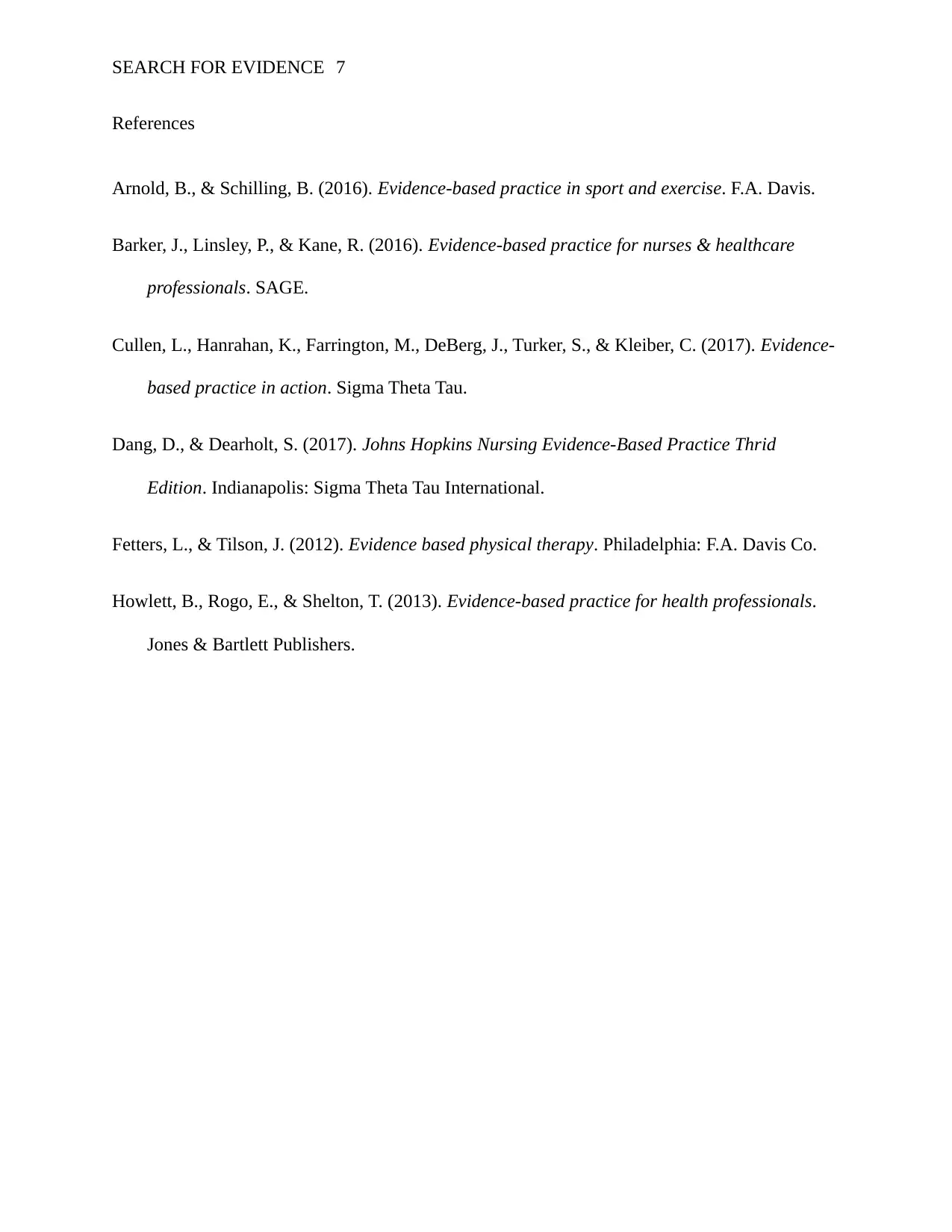
SEARCH FOR EVIDENCE 7
References
Arnold, B., & Schilling, B. (2016). Evidence-based practice in sport and exercise. F.A. Davis.
Barker, J., Linsley, P., & Kane, R. (2016). Evidence-based practice for nurses & healthcare
professionals. SAGE.
Cullen, L., Hanrahan, K., Farrington, M., DeBerg, J., Turker, S., & Kleiber, C. (2017). Evidence-
based practice in action. Sigma Theta Tau.
Dang, D., & Dearholt, S. (2017). Johns Hopkins Nursing Evidence-Based Practice Thrid
Edition. Indianapolis: Sigma Theta Tau International.
Fetters, L., & Tilson, J. (2012). Evidence based physical therapy. Philadelphia: F.A. Davis Co.
Howlett, B., Rogo, E., & Shelton, T. (2013). Evidence-based practice for health professionals.
Jones & Bartlett Publishers.
References
Arnold, B., & Schilling, B. (2016). Evidence-based practice in sport and exercise. F.A. Davis.
Barker, J., Linsley, P., & Kane, R. (2016). Evidence-based practice for nurses & healthcare
professionals. SAGE.
Cullen, L., Hanrahan, K., Farrington, M., DeBerg, J., Turker, S., & Kleiber, C. (2017). Evidence-
based practice in action. Sigma Theta Tau.
Dang, D., & Dearholt, S. (2017). Johns Hopkins Nursing Evidence-Based Practice Thrid
Edition. Indianapolis: Sigma Theta Tau International.
Fetters, L., & Tilson, J. (2012). Evidence based physical therapy. Philadelphia: F.A. Davis Co.
Howlett, B., Rogo, E., & Shelton, T. (2013). Evidence-based practice for health professionals.
Jones & Bartlett Publishers.
Paraphrase This Document
Need a fresh take? Get an instant paraphrase of this document with our AI Paraphraser

SEARCH FOR EVIDENCE 8
1 out of 8
Related Documents
Your All-in-One AI-Powered Toolkit for Academic Success.
+13062052269
info@desklib.com
Available 24*7 on WhatsApp / Email
![[object Object]](/_next/static/media/star-bottom.7253800d.svg)
Unlock your academic potential
Copyright © 2020–2025 A2Z Services. All Rights Reserved. Developed and managed by ZUCOL.





